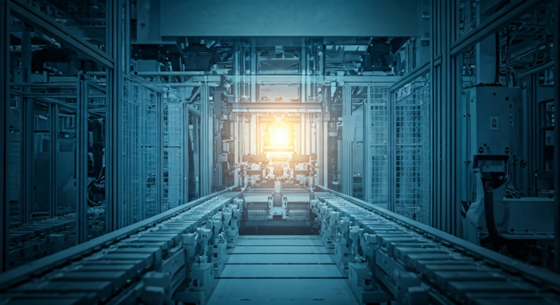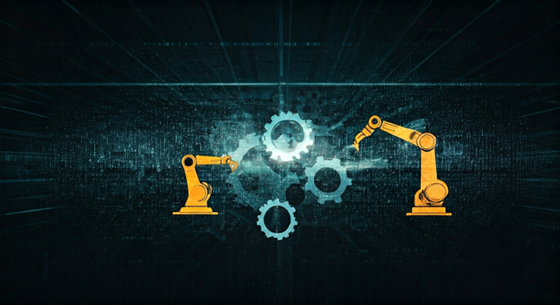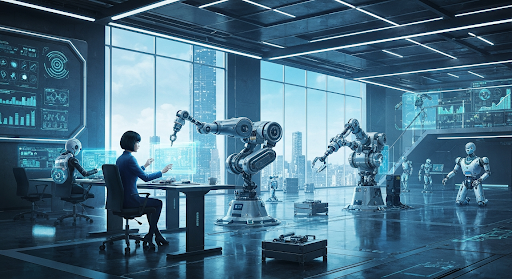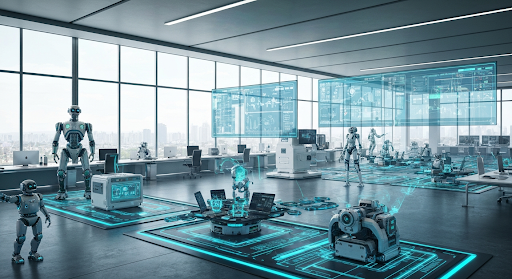Enhance Your Workflow with Automatic Production Techniques
Key Highlights
- Automated production lines enhance efficiency and reduce human errors, paving the way for streamlined processes.
- Robotics and artificial intelligence contribute to precise manufacturing, driving innovation across industries.
- Real-time data collection and Internet of Things (IoT) revolutionize decision-making and predictive maintenance.
- Flexible systems allow production lines to adapt to shifting market conditions and customer demand effectively.
- Cost-efficient automation projects depend on workforce training and thorough cost management.
- Leveraging automation grants businesses a vital competitive advantage amidst evolving industrial landscapes.
Introduction
Automation has changed how we make things by adding robotics and artificial intelligence to the way production lines work. These changes help to make work much more precise, fast, and ready to keep up with demand. With automation, companies get a good chance to stay ahead in fast-moving markets. To do well, businesses need to know the important parts of automation and face any problems that show up. They should also be open to new ways and use the best practices. This will help the company grow, keep up with new ideas, and win in the tough world of industry today. Automatic Manufacturing Limited: Innovations That Matter
Each type of system helps brands and manufacturers in their own way. They let people choose which automation system will best fit their company’s work goals.
The Evolution of Automated Production in the U.S.
From Manual Labor to Mechanized Systems
Manufacturing used to depend on people doing all the work by hand. Workers would be in charge of every part of production. This way let people show their skill, but the output speed and consistency were often low. Later, the use of machinery and conveyor belts helped work get done faster and increased production capacity.
Machinery and conveyor belts made it possible to standardize jobs and cut down on labor costs. By switching from human hands to machines, businesses could better control how fast and how evenly things got made. This started the move toward automation.
Today’s production keeps building on those first changes. People now aim for more precision and greater efficiency while needing less human intervention. The switch from all-manual work to using machines is what keeps driving new ideas, pushing to get the best performance in all industries.
Impact of Industry 4.0 on Manufacturing
Industry 4.0 is a big change for the way we make things. It brings together sensors, IoT, and real-time data collection in the factory. These tools let machines, people, and controllers always talk to each other and work better together. This makes smart manufacturing possible.
The live data from sensors help businesses find where things are not working and fix them fast. This makes sure that work moves along as it should and also shows when a machine needs some care before it breaks. When you use IoT, your system answers quicker. This leads to less time when machines are stopped and helps all parts of the system be more reliable.
When manufacturers use Industry 4.0, they save resources and use them better. This digital setup helps improve quality and makes sure working steps are smooth. It also gets factories ready for what they will need in the future.
Key Components of Modern Automated Production Lines

main part of modern production lines is tools like robotics, sensors, and control systems. These work together to bring precision and make work smooth on the line. This helps businesses get good results with better consistency for all of their operations.
New technology like artificial intelligence and IoT gives us more ways to watch and improve the work. There is less need for human intervention because these systems can make real-time changes on their own. This is why today's production lines show what automation can really do.
Robotics and Machine Integration
Robots have changed the way people work in factories. They take on jobs that need to be done with great care, speed, and safety. These machines help by taking away some of the work, especially for jobs that are dangerous or done over and over again. This boosts how much can get done in a day.
Bringing robotics into daily work means making sure they work well with other parts like sensors, conveyor belts, and controllers. Advanced tools like PLCs help keep everything running together. These tools help everything flow without stopping and fit the work to what is needed for that day.
When all the machines are set up right, the automated lines do well. They can change when they need to and keep moving as quickly as possible. This is all done with very little human intervention, which makes things safer and lets people respond fast when something new is needed.
Sensors, IoT, and Data Analytics
Sensors be the eyes and ears of automated production lines. They keep gathering data all the time to help things run better. IoT platforms use this data to help people make quick decisions and plan ahead for maintenance.
Each part of the system gives exact production info to analytics software. This helps to find patterns and spot issues that should not be there. That way, it makes product quality better and helps work flow faster and smoother.
Using IoT-driven analytics makes production lines smarter. It also helps the work grow to fit more needs and makes sure people and materials are used in the best way. All of this changes the way automation makes manufacturing better.
Designing for Efficiency: Best Practices in Automation
Efficiency in automation starts when you set up a good workflow and organize the steps well. This helps move materials in the right way. It also cuts down on slow spots and hold-ups. When you pick the right tools and machines to work with this system, you get even better results out of your production lines.
These smart moves help lower costs. They give you more precision in your work. Your system can also grow as your needs change over time. At the same time, you can keep your product quality high, which is very important for any automated production lines.
Workflow Optimization and Layout Planning
Smooth workflows help strong production lines work well. They let you use resources in a good way and cut down on steps you do not need. Good planning of the layout is key to making everything work together.
Key strategies include:
- Put equipment and conveyor belts where they make sense for the flow of materials
- Make the distance between steps in the production line as short as you can
- Set up layouts so workers can reach things for maintenance without trouble
- Use modular workstations so you can change things easily if you need to
If you think about these things, your production line will be quick and ready to handle change. The setup will stay strong even when the market changes.
Selecting Equipment and Technology for Peak Performance
Choosing the right equipment is key for automation. It is important to pick machinery that fits the needed precision, workload, and work with other machines. This helps make all tasks in production much easier.
Controllers and PLCs help join the tech together by syncing the equipment and keeping things accurate. When companies use analytics platforms, they also can check how well everything is working at any time.
If manufacturers spend money on good technology, they get ready for tough competition. This helps them stay strong and ready for new needs in the industry as things change.
Innovation Drivers in Automated Production

automation world grows with new ideas from machine learning, artificial intelligence, and smart customization tools. These changes help production lines be more flexible and work better. They can be set up to fit many different needs.
When companies use these tools, they stay ahead. They can make high-quality things and quickly keep up with changes in the market.
Artificial Intelligence and Machine Learning Applications
This is paragraph text. Click it or hit the Manage Text button to change the font, color, size, format, and more. To set up site-wide paragraph and title styles, go to Site Theme.
Customization and Flexibility in Production Lines
Production customisation has changed how people make things. It helps companies manage the different wants of customers and needs of each industry. Now, flexible systems let them quickly change product design and production capacity.
With modular machinery and adaptive controllers, makers can handle changes in demand fast. There are no long waits and not too much spending. This keeps things simple and stops too much waste.
Being able to move quickly like this makes customers happy. They get products made just for them. Also, it helps companies stay strong against others in the market.
Overcoming Challenges When Automating Production
Using automation comes with some big challenges. There are often high costs at the start. Companies also need to train their workers for new things. It is important to get employees ready with the right skills. You also need to handle how new technology fits in with what is already there.
If you look at ROI numbers and deal with pushback, you can get the most out of automation. This can help companies cut risks and find new ways to grow.
Addressing Workforce Training and Change Management
Employee training is key for good change management when a company adds automation. Workers need to learn new jobs that include watching over and working with automated systems.
To help deal with emotional challenges like resistance, it is important to talk openly and involve everyone. Being clear and open helps people trust each other, so changes in production go more smoothly.
Ongoing training helps everyone stay skilled. This is good because it lowers mistakes and helps everyone work toward the same goals that automation brings.
Managing Costs and Return on Investment
Automation demands high initial investments, balancing these with long-term savings hinges on thorough ROI evaluations. Cost components range from hardware procurement to employee retraining.
Text Table Example:
Cost Factors Potential Savings ROI Considerations
Equipment/Setup Reduced labor costs Higher production throughput
Workforce Training Minimized errors Enhanced product consistency
Maintenance Energy savings Sustainable operational costs
Detailed tracking ensures sustained benefits that outweigh investment hurdles over time.
Conclusion
In short, automation is not only a way to make production faster. It also helps bring new ideas into the work. There has been a big change from people doing tasks by hand to using smart machines and tools, like robotics, IoT, and AI. When you use the best ways to make your work run smooth and allow for personal choices, you can get more done. But there are things you have to think about, like teaching your team new skills and keeping costs under control. The world of business keeps changing, so it is very important to stay up-to-date and able to adjust. That is how you make the most of automation. If you want to make your production better, get in touch with us now for a free talk.
Frequently Asked Questions
What industries benefit most from production automation?
Industries such as automotive, electronics, food processing, and pharmaceuticals use automation to help their work. These industries depend on production lines. With automation, they can lower their labor costs, get more work done, and keep the quality and look of their products the same each time.
How does automation impact job opportunities in manufacturing?
Automation moves jobs away from manual tasks. Now, people focus more on looking after robotics, watching over systems, and training for new skills. With automation, there are less human errors. This makes things more efficient. At the same time, people find new, special jobs that are about keeping automated systems working well.
What are common obstacles companies face in automation projects?
Some challenges are getting over high starting costs, dealing with workers who do not want change, fixing problems when joining systems, and worries about losing jobs. Using the right steps to manage change can help businesses boost their production capacity and get more work done well.
How can small and medium businesses adopt automation cost-effectively?
Small and medium businesses can bring in automation without spending too much by finding out which tasks are done again and again. They should use cloud-based solutions as well, so they do not have to pay for heavy equipment. Businesses need to get technology that can grow with the team and needs. It is also smart to look for government grants or subsidies to help with costs. Working with tech partners for automation, who can make custom plans for the business, helps use resources better and keeps spending low.
What are the latest trends in manufacturing automation?
Recent trends in manufacturing automation show many changes. Companies now use AI and machine learning for predictive maintenance. This helps them know about possible problems before they happen. There is also more use of collaborative robots, or cobots, that work with people. This makes human work easier and faster. The number of IoT-enabled devices is also going up. These devices give real-time data analytics. With this data, decision-making in the factory gets better and quicker. All these things help the industry to use automation and AI in new ways.




